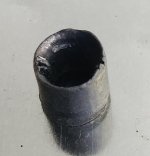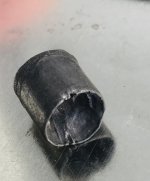I have the intention to shoot this type of handgun
can someone with experiences give me some hinds
I shoot a winchester 1873 musket 44/40 and reload with vihtavuori N340 8 gn a 200 gn lead bullet sized 428 at 100m
this load works very well in this type of rifle this powder has the same burning rate as imr sr4756 or Longshot from hodgdon or herco from alliant .
please advice your loads
greetings from flanders
Jarmann
The .44 S & W "DA"s and "SA"s were made for Black Powder Cartridges....none were approved by S & W for use with 'Smokeless'...
Originally the Black Powder .44-40 Cartridge was only one 'Standard' Cartridge and one Standard Loading, and any small variations within this were of no importance...
The .44-40 was the same Cartridge for anything chambering it, but, over time, this changed, and with the advent of Smokeless Propellants, and of erstwhile Black Powder Rifle Cartridges changing over to Smokeless, the Rifle Cartridges proper became more powerful, began having Semi-Jacketed Bullets, and the Rifle Cartridges could then be unsuited and too powerful for the early Black Powder era Revolvers.
This happened with .32-20 also, and people ruined a lot of lovely old .32 -20 Revolvers firing 'Modern' Era Smokeless Rifle Cartridges in them.
Ideally, just stay with Black Powder Loads for your old "DA" S & W Top Break .44-40.
If you want to shoot same Loads in a Revolver as you describe using in your Rifle, get a modern Colt S.A., or an Italian reproduction 'Colt' Single Action Army, and use it.
All is well then! And no worries...
"Trail Boss" or other bulky weaker Smokeless Propellants might be alright if used properly for the actual Antique Arm in question, and Loading Tables should be available for them, for a range of .44-40 Loadings, which would be safe for Antique Revolvers.
Personally I do not load any kind of Smokeless in any Black Powder era Revolvers, mostly because the original Loadings are the most fun, realistic, actual, and satisfying, but also, because I am automatically 100 percent "Fail Safe" this way with no chance of any over-pressure events.




